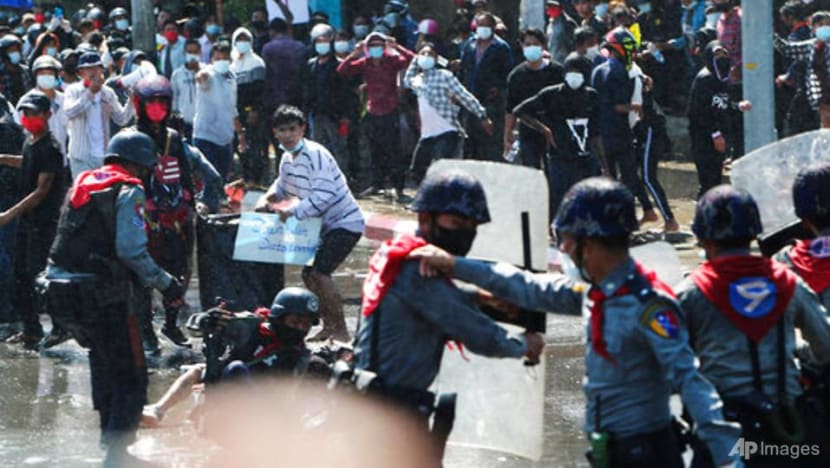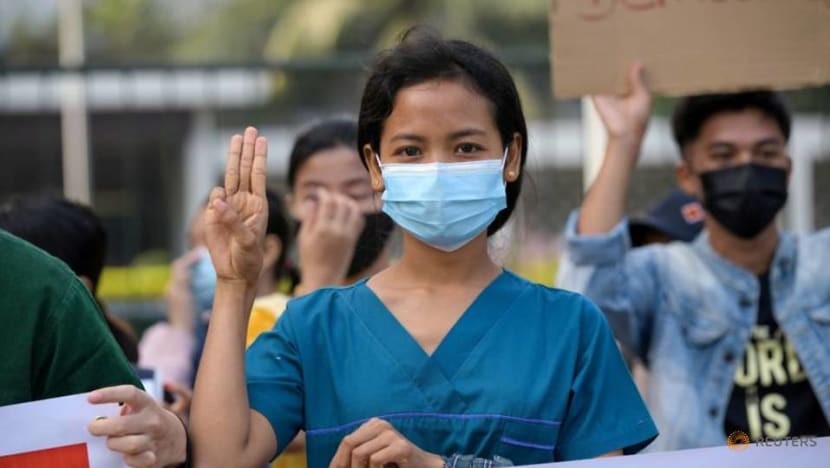How protesters in Myanmar get around social media and Internet blackouts

Protesters run after police fire warning-shots and use water cannons to disperse them during a protest in Mandalay, Myanmar on Feb 9, 2021. (Photo: AP)
SINGAPORE: Images and videos of protests across Myanmar have been broadcast and shared online in the past week almost immediately as events unfolded in the country, a far cry from how it was in the past.
With smartphones in the hands of more than 20 million people in the country, it has been impossible to stem the flow of information to and from the outside world.
"The potential is that people can communicate, take eyewitness accounts, and then circulate those quickly via messaging, by social media, on Facebook and by the Internet," said Professor Gerard Goggin from the Wee Kim Wee School of Communication and Information, Nanyang Technological University.
Mobile phones and a boom in telecommunications in the past decade have changed lives in the country of 52 million, and now play an important role in the current political crisis. A few major changes have led to this, experts CNA spoke to said.
"Myanmar in ... 2021 is plugged into regional communication and connectivity networks in a way that the Burma crumbling from a closed economy and isolation under Ne Win's socialist rule in 1988 was not," said Ms Moe Thuzar, co-coordinator of ISEAS-Yusof Ishak’s Myanmar Studies programme, adding that back then, messages and video recordings were "smuggled" out of the country.

READ: Myanmar anti-coup protests resume despite bloodshed
"INTERNET EXPLOSION"
While the country had access to the Internet since 2000, it was a luxury few could afford and a SIM card could reportedly cost US$1,000 to US$2,000. Still, news and photos of the Saffron Revolution in 2007 were put on websites and blogs, ensuring worldwide coverage.
Fast forward to 2021, and pre-paid top up cards for mobile phones are a cheap and common commodity.
The Internet and smartphone boom came in 2013 when the state monopoly over phone services ended. As of 2020, Myanmar has four telecom operators and more than 140 Internet service providers.
READ: Myanmar military raids Aung San Suu Kyi's party offices as UN slams violence
There were 22 million Internet users and 68 million mobile connections in Myanmar as of January last year, with a Internet penetration rate of more than 40 per cent.
"Myanmar was a closed system, but the last decade has witnessed a dramatic change. International telecommunication operators saw an opportunity and opened shops," said Assistant Professor Saifuddin Ahmed, also from the Wee Kim Wee School of Communication and Information.
"This facilitated the widespread availability of mobile phones and a lowering of SIM card cost, which in turn enabled the growth of the Internet and social media use in the country."
There has been an "Internet explosion" and a plethora of Myanmar-language apps are on smartphones now, said Ms Moe Thuzar.
"Facebook is the important - indeed premier - platform for people in Myanmar to share information and updates, and rally the current movement protesting the unlawful military takeover in Myanmar," she said.
Besides the protests, there has been a burgeoning civil disobedience campaign with essential workers staging strikes.
GETTING AROUND RESTRICTIONS
Social media platforms such as Facebook continue to be blocked in the country although an Internet blackout over the weekend has been lifted.
A communications specialist in Yangon, who asked not to be named, told CNA that they have been using virtual private networks or VPNs to get around the restrictions and access platforms like Facebook and WhatsApp.
During the blackout, which was lifted on Sunday, they created SMS groups to update each other, and called their relatives and friends from different townships every hour to keep in contact, she said.
Commentary: A crackdown in Myanmar could spark a humanitarian crisis
Ms Moe Thuzar said that when the junta attempted to block Internet access after the coup last week, Myanmar netizens migrated to Twitter, which is relatively new for most social media users in Myanmar who are more used to posting and sharing in Burmese.
From Viber and Messenger, many have also moved to WhatsApp and increasingly, Signal, for messaging.
They also widely shared tips and techniques on using VPNs to avoid potential interception or monitoring, she said.

"The current movement is country-wide and ... because most communication is in Burmese, there is a wider reach, and people - especially the youth in semi-urban or rural areas are as connected to the movement as their peers in urban towns and cities," she said.
Prof Goggin said that the Internet is, like electricity, an essential service by now, and social media and messaging platforms have "really taken off" in the last five years or so.
"I think that that combined is a recipe for digital media being an even bigger tool or amplifier, for people's opinion, for action and for coordination."
INTERNET BLACKOUTS FUTILE
It is a phenomenon that is seen not just in Myanmar but across the world, experts said.
"Protesters worldwide are becoming tech-savvy and find means to circumvent the government restrictions. We have witnessed this in Egypt, Hong Kong, India, and many other societies," said Asst Prof Saifuddin.
Even when there were no Internet services, mesh networks apps like Bridgefy allowed protesters to communicate and help information go viral, he said.


It also means that protest movements around the world have been drawing inspiration from each other. Protesters in Myanmar have been flashing a three-finger salute, which has been used by protesters in Thailand since 2014.
The gesture, borrowed from the Hunger Games sci-fi series, was also seen during the Hong Kong protests.

It is another sign of how the flow of information across borders is hard to stop. Protesters, aware that they are being watched around the world, are also holding up protest messages in English to communicate to a global audience.
Experts said that Internet shutdowns are a "crude tool" that have their limits.
"Such blockades can slow the spread of information, but it possibly cannot completely block the information spread indefinitely," said Asst Prof Saifuddin.














